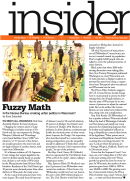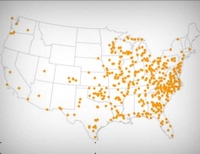Wisconsin
Problems
When legislators rely on the Census Bureau's prison counts to draw legislative districts, they unintentionally give extra representation to the districts that contain prisons and dilute the voices of everyone else. It's called "prison gerrymandering." It plays out in Wisconsin on two levels:
- Wisconsin engages in prison gerrymandering for state legislative districts.
- Wisconsin counties and cities provide some of the most dramatic instances of prison gerrymandering in the nation.
Prison gerrymandering violates the constitutional principle of "one person, one vote." The Supreme Court requires districts to be based on equal population in order to give each resident the same access to government. But a longstanding flaw in the Census counts incarcerated people as residents of the prison location, even though they cannot vote and are not a part of the surrounding community.
Wisconsin law considers incarcerated people to be residents of their home addresses: a person's residence is determined by "where the person's habitation is fixed, without any present intent to move, and to which, when absent, the person intends to return." (Wis. Stat. § 6.10) Since most incarcerated people intend to leave prison and do not intend to return, prison is not their residence. Using the Census Bureau's prison count data for redistricting purposes is inconsistent with Wisconsin's residence law.
Impact at the state level
- In 2011, the legislature used 5,583 incarcerated people to pad out the population of District 53. Without the incarcerated populations, the district is 10% below the required size. This gives every 90 residents of the 53rd district the same influence as 100 residents of any other district in the state.
- District 53 purports to have a large African-American population, larger than 74 other districts. But of the 2,784 African-Americans in the district, all but 590 are incarcerated. The day the people incarcerated in the district are allowed to vote again, they will be on a bus, heading back to their home district. The 53rd District is claiming populations that are not a part of this district and never will be.
Crediting all of Wisconsin's incarcerated people to a few locations enhances the political clout of the people who live near prisons, while diluting the voices of the residents of all other districts in the state.
Impact at the county and municipal level
Because state law is read to require prison gerrymandering (70 Wis. Op. Atty. Gen. 80 (1981)), Wisconsin provides many dramatic examples of the problem:
- 80% of a district in Juneau County is incarcerated. This gives every 20 residents of that district the same voice as 100 residents of any other ward.
- 75% of District 2 in Waupun County is incarcerated.
- 62% of Adams County's Districts 13 and 5 are incarcerated.
- 53% of a district in Juneau City is incarcerated.
- 51% of Jackson County's District 12 is incarcerated.
- We've also identified the problem of prison gerrymandering in 16 other Wisconsin cities and counties (Baraboo, Boscobel, Chippewa Falls, Elkhorn, Fitchburg, Franklin, and Racine cities and Chippewa, Columbia, Dodge, Fond du Lac, Racine, Sawyer, Sheboygan, Waushara, Winnebago counties)
Nevertheless, there are also a number of examples of communities successfully rejecting the Census Bureau's prison counts:
- Five cities and counties avoided prison gerrymandering: the cities of New Lisbon, Portage, Prairie du Chien, and Stanley, and Crawford county.
Organizations in Wisconsin
It’s impossible to include everyone who is working toward fair districting in Wisconsin, but if you are looking to get involved, these are some of the people and organizations you might want to contact:
- Representative Frederick Kessler, sponsor of AJR63, which requires that districting be based on census data that does not included disenfranchised incarcerated people.
- League of Women Voters of Wisconsin
Endorsements
Fact sheets
A summary of the problem with an emphasis on legislative solutions for the state. Originally prepared for a Midwest Democracy Network conference in February 2013:
Fact sheets originally prepared in 2009:
Regional impact fact sheets prepared in 2020:
- Prison Gerrymandering in Adams County [PDF]
- Prison Gerrymandering in Baraboo [PDF]
- Prison Gerrymandering in Boscobel [PDF]
- Prison Gerrymandering in Chippewa County [PDF]
- Prison Gerrymandering in Chippewa Falls [PDF]
- Prison Gerrymandering in Columbia County [PDF]
- Prison Gerrymandering in Dodge County [PDF]
- Prison Gerrymandering in Elkhorn [PDF]
- Prison Gerrymandering in Fitchburg [PDF]
- Prison Gerrymandering in Fond du Lac County [PDF]
- Prison Gerrymandering in Franklin [PDF]
- Prison Gerrymandering in Jackson County [PDF]
- Prison Gerrymandering in Juneau County [PDF]
- Prison Gerrymandering in Juneau [PDF]
- Prison Gerrymandering in Racine County [PDF]
- Prison Gerrymandering in Racine [PDF]
- Prison Gerrymandering in Sawyer County [PDF]
- Prison Gerrymandering in Sheboygan County [PDF]
- Prison Gerrymandering in Waupun [PDF]
- Prison Gerrymandering in Waushara County [PDF]
- Prison Gerrymandering in Winnebago County [PDF]
Additional reading
- By counting incarcerated people where they're incarcerated, Wisconsin shifts voter clout from cities to small towns, Milwaukee Journal Sentinel, by Natasha Haverty, October 15, 2021
- Legislation: including model legislation, current bills, and archive of past legislative efforts
- Pathfinder: a guide to resources on prison gerrymandering
- The Redistricting Data Hub's report estimating the effect of prison gerrymandering in Wisconsin in the 2020 redistricting cycle.
- Importing Constituents: Prisoners and Political Clout in Wisconsin (2008) is our district-by-district analysis of how crediting Milwaukee’s incarcerated residents to remote districts distorts democracy and violates the federal and state constitutions. Analysis is based on redistricting after the 2000 Census.
- An updated analysis of prison-based gerrymandering in Wisconsin's 2011 redistricting effort: Wisconsin sees dramatic prison-based gerrymandering in new state, county, city districts (2011).
- Hearing on AJR63, September 15, 2009. Watch Listen
-
 Fuzzy Math: Is the Census Bureau creating unfair politics in Wisconsin?, by Evan Solochek, Milwaukee Magazine March 2008
Fuzzy Math: Is the Census Bureau creating unfair politics in Wisconsin?, by Evan Solochek, Milwaukee Magazine March 2008  Lawmakers debate counting non-voting prisoners in census [RealMedia], by Shawn Johnson, Wisconsin Public Radio July 7, 2009
Lawmakers debate counting non-voting prisoners in census [RealMedia], by Shawn Johnson, Wisconsin Public Radio July 7, 2009
Events
- April 15-17, 2025:
Sarah Staudt, our Director of Policy and Advocacy, will be attending the MacArthur Safety and Justice Challenge Network Meeting from April 15-17 in Chicago. Drop her a line if you’d like to meet up!
Not near you?
Invite us to your city, college or organization.




